AMD's Radeon HD 5670: Sub-$100 DirectX 11 Starts Today
by Ryan Smith on January 14, 2010 12:00 AM EST- Posted in
- GPUs
Power, Temperature, & Noise
As a note here, since NVIDIA does not offer a reference GT 240, we’re using our Asus 512MB GDDR5 GT 240 as our reference 240. It does have a dual-slot cooler, so the cooler is not directly comparable to the blower on the 5670.
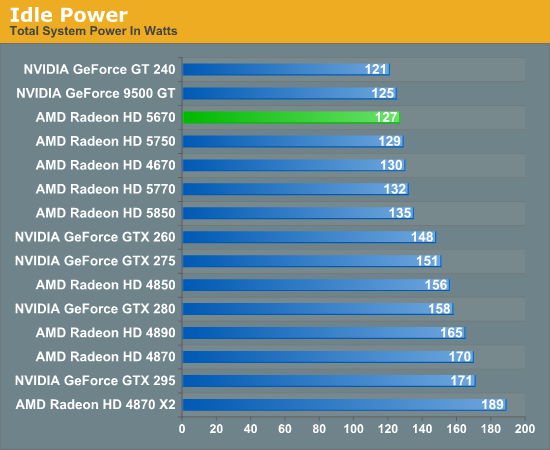
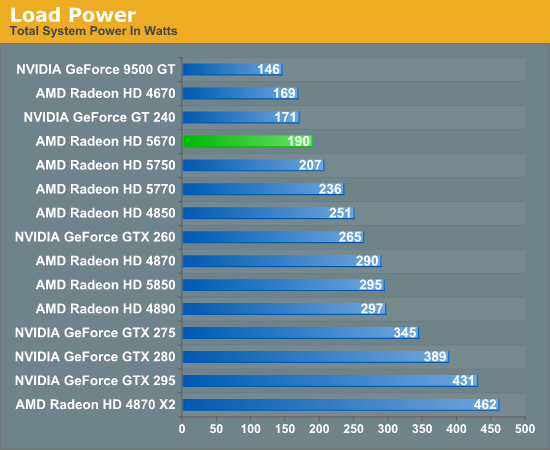
The one thing AMD can’t quite best the GT 240 at is idle power. Here the GT 240’s sub-10W idle means the 5670 idles slightly higher. With that said it’s the 3rd lowest card of all time, behind only the GT 240, and the significantly slower 9500 GT.
Load power paints a different picture however, and this is where the concept of a “power virus” pokes its head up again. The 5670 has a lower TDP than the GT 240 according to the specs published by AMD and NVIDIA - at 61W and 70W respectively - and we have no reason to doubt these numbers. But here the load power of the 5670 is much higher, by just shy of 20W. You’ll notice here that the 4670 is also much lower in spite of similar specs – all of this leads us to believe that the other cards are throttling themselves some as compared to the 5670, whose VRM protection features let it run away compared to these cards. Compared to the 5750 the data is correct, so that makes a better reference point than the GT 240 or 4670.
Accounting for these quirks, the 5670 should be between the 3rd and 2nd lowest power consuming card that we have on-hand.
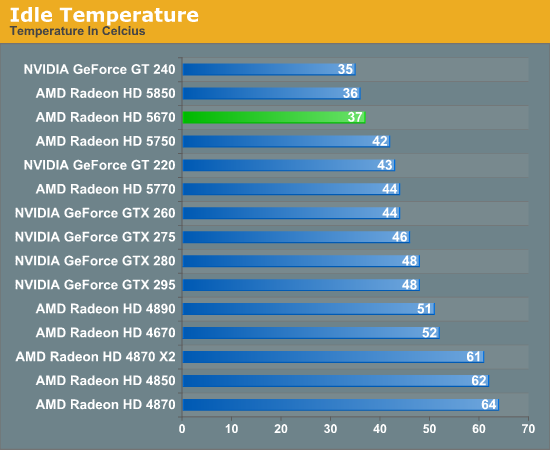
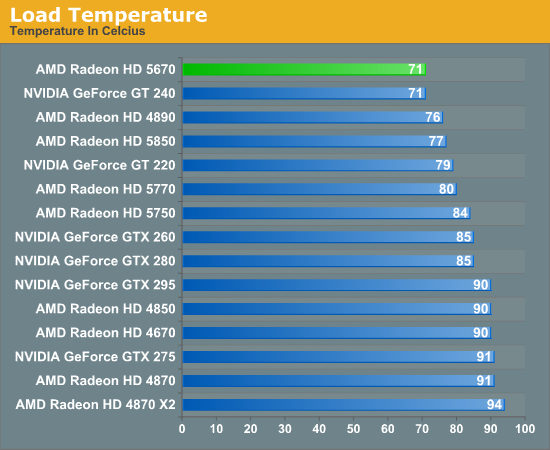
Less power usage leads to less heat, and in this case this means the 5670 once again trails the GT 240, which benefits from said lower power usage and the dual-slot cooler on our specific card. It’s still the 3rd best card however, beating everything except said GT 240 and the remarkably cool 5850.
At load, the picture looks very good for AMD. Even though we’re using a dual-slot cooler, thanks to the low load power usage we’re looking at a tie for the lowest load temperatures we’ve ever recorded. The dual-slot GT 240 ties at 71C, and we’re several degrees from anything else. The results are particularly good compared to the 4670, which was an inferno at 20C higher in this test.
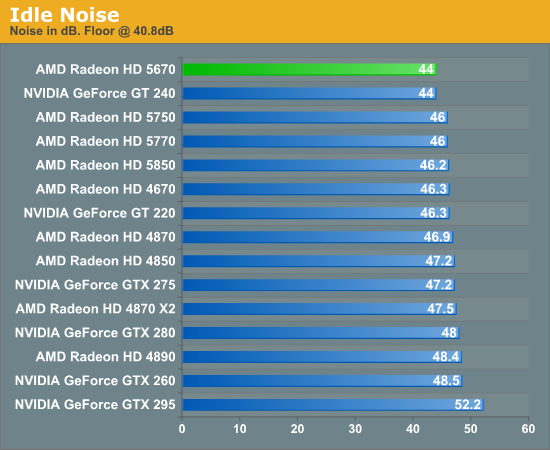
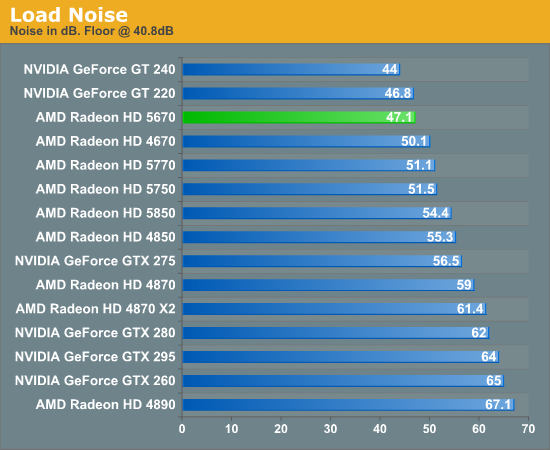
Finally there’s noise. As is the case with all of our other cards, the noise at idle is virtually indistinguishable from the noise generated by the rest of the computer.
At load the 5670 continues to be a quiet card, at only 3dB louder than idle. The only thing it falls behind here are the GT 220 and GT 240, both of which use dual-slot coolers and can afford the use of a larger, quieter fan. This is actually very impressive for a single-slot blower.
All of this data points to the 5670 making for a good HTPC card, certainly one as good if not better than the GT 200 series, and definitely better than the 4670. It’s cool and quiet, everything an HTPC card needs. However we’re more interested in where the 5500 series would place here – few HTPCs need this much rendering power, and with the 5500 series sub-50W power draw, it may be an even better choice.










73 Comments
View All Comments
JarredWalton - Sunday, January 17, 2010 - link
As far as CPU multiplier, if you have the i7-720QM the normal multiplier is 12X (133 bus * 12 = 1.6GHz). For the i7-820QM the stock multiplier is 13 (1.73GHz). Maximum Turbo mode on the 720QM is 2.80GHz, so you could potentially see a 21X multiplier, while on the 820QM the maximum Turbo is 3.066GHz so you'd see up to a 23X multiplier. I don't know if throttle stop tells you max and min multipliers or not, but you could even run CPU-Z and just watch to see if the multiplier is changing a lot.SlyNine - Tuesday, January 19, 2010 - link
Yea I have been watching a few programs including throttle stop, Realtemp and Realtemp GT, including I7 turbo. They all show the max multiplier at 7-9 when gaming under load, even with an external monitor hooked up and this screen off it doesn't go past 10. Its worth noting that with the screen brightness turned down and CPU load only they stay at 12, but turn the brightness up and your multi falls to 8.The biggest problem is the clock modulation, which I'm trying to test. But it definitely correlates with real world performance, while task manager may show the CPU at 100%, throttle stop reports a 75% reduction in CPU usage. This also correlates with the delta that taskmanager indicates CPU usage at and what programs like I7turbo and real temp show the C0 state percent. Task manager will show 100% while the C0% will be at 25%, indicating a 75% reduction while under load.
Perhaps throttle stop just measures the difference between the CO% and what the OS reports.
I've custom set all the settings in the advanced power options to be the same on and off battery. When you unplug the system runs a great deal faster, albeit at the risk of harming the battery. I've disabled speed step as well with no difference.
Excel isn't my strong suit(basically I'm going to have to relearn how to use it) but I'm trying to correlate frame rate with the indicated clock modulation. But I'm unsure how to record a timeline of FPS. It does appear though that the FPS do report accurately when the clock modulation kicks in.
satish2685 - Monday, April 1, 2013 - link
Hi, I would like to purchase an Entry level 1GB DDR3 Asus Geforce HD5450 Graphics Card, but considering the power requirements, i only have an 250W PSU. Is it ok to buy a graphic card that requires a minimum of 400w and connect it to my existing MB or do i need to upgrade my PSU?? Advice required. If so any consequences i could face in future ??